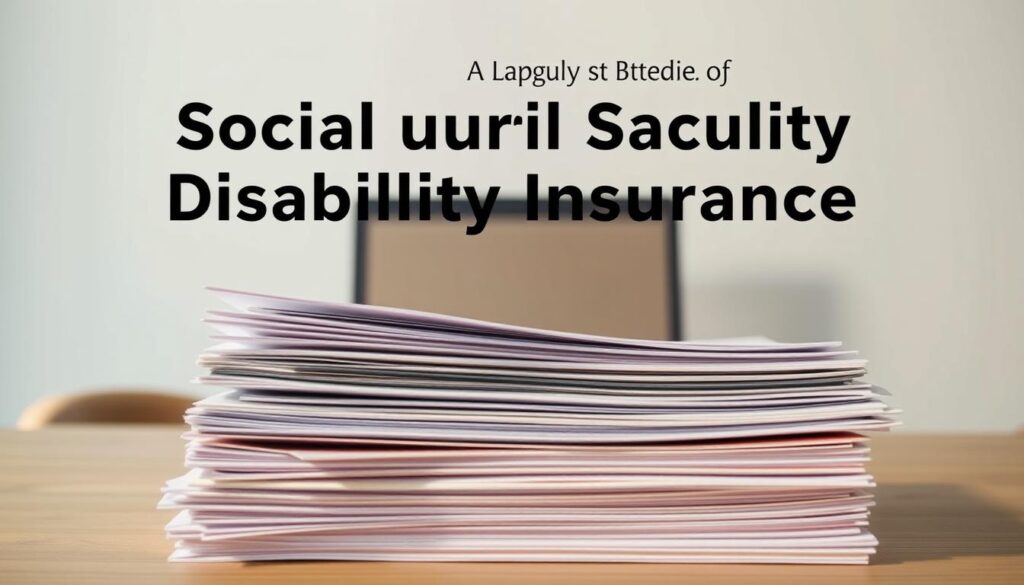Advanced Disability Benefits Estimator
Discover Your Potential Benefits
Are you curious about what disability benefits you might qualify for? Let's find out together!
Navigating the application process for Social Security Disability Insurance (SSDI) can be daunting, especially when dealing with health issues that prevent you from working.

This comprehensive guide is designed to walk you through each step of applying for disability benefits, with a particular focus on applicants nearing retirement age. Understanding the eligibility criteria and application process can significantly improve your chances of approval.
We’ll cover determining eligibility based on your work history and medical condition, completing necessary forms, and gathering supporting documentation to ensure a smooth application process for your benefits.
Understanding Social Security Disability Insurance (SSDI)
The Social Security Disability Insurance program provides essential benefits to workers who have contributed to the Social Security system and become disabled before retirement age. It is a federal program administered by the Social Security Administration (SSA).
SSDI is distinct from Supplemental Security Income (SSI), which is a needs-based program. To qualify for SSDI, individuals must have worked long enough and recently enough to accumulate sufficient work credits.
What is SSDI and How Does it Differ from SSI?
SSDI is an earned benefit based on an individual’s work history and the Social Security taxes paid. Unlike SSI, SSDI requires a work history but does not have strict income and asset limitations. Key differences between SSDI and SSI are highlighted in the following table:
| Program | Eligibility Basis | Income/Asset Limitations |
|---|---|---|
| SSDI | Work History and Disability | No |
| SSI | Needs-based (Disability, Income, Resources) | Yes |
Understanding these differences is crucial for determining which program to apply for based on individual circumstances and work history. SSDI benefits begin after a five-month waiting period, and Medicare eligibility typically starts 24 months after SSDI benefits begin.
Social Security Disability Benefits at Age 60: Special Considerations
As individuals approach the age of 60, the likelihood of experiencing a disability that interferes with their ability to work increases significantly. According to the data, about two-thirds of new disabled-worker awardees in 2013 were aged 50 or older, and nearly one in five were aged 60 or older.
The Social Security Administration (SSA) recognizes that as workers age, their ability to adjust to new types of work becomes more limited, particularly when they have severe medical conditions. At 60, applicants have distinct advantages in the evaluation process compared to younger applicants.
How Age Affects Disability Determinations
The SSA applies more lenient standards through the “Medical-Vocational Guidelines” or “Grid Rules” at age 60, making it easier to qualify for disability benefits. Older workers may face additional challenges in transitioning to new occupations, especially if they have limited education or transferable skills.
The SSA considers that even if an individual could theoretically perform some type of work, it may not be reasonable to expect them to learn a new occupation at this stage of their career. The closer one is to full retirement age, the more weight the SSA gives to factors like age when evaluating a disability claim.
SSDI Eligibility Requirements
To qualify for Social Security Disability Insurance (SSDI), applicants must meet specific eligibility requirements. The Social Security Administration (SSA) evaluates an individual’s work history to determine their eligibility for disability benefits.
Work Credits: How Many Do You Need?
The SSA requires applicants to have earned a certain number of work credits to be eligible for SSDI. Generally, workers are insured for benefits if they have worked and earned at least one-fourth of the maximum possible work credits since reaching age 21. Most applicants have substantial work histories that satisfy these requirements.
The Recent Work Test and Duration of Work Test
The SSA applies two specific tests to determine if an applicant has worked enough to qualify for disability insurance: the Recent Work Test and the Duration of Work Test. The Recent Work Test ensures that the applicant has worked recently enough, typically requiring 20 credits in the 10 years before becoming disabled. The Duration of Work Test examines the applicant’s entire work history, with most 60-year-old applicants needing at least 9.5 years of total work under Social Security.
Social Security’s Definition of Disability
Understanding the Social Security Administration’s definition of disability is crucial for navigating the SSDI application process. The Social Security Administration’s definition of disability is widely recognized as one of the strictest among developed nations.
The Organisation for Economic Co-operation and Development, which includes 34 member countries, describes the U.S. system as having “the most stringent eligibility criteria for a full disability benefit, including the most rigid reference to all jobs available in the labour market.” This stringent definition requires that a person’s condition prevents them from performing any substantial work that exists in the national economy.
The Five-Step Evaluation Process
The Social Security Administration uses a five-step evaluation process to determine disability. This process assesses whether an individual is engaged in substantial gainful activity, the severity of their medical condition, and their ability to perform their previous work or other work in the national economy.
The evaluation considers factors such as age, education, and work experience to determine if an individual can adapt to new types of employment.
Why Social Security’s Definition is Considered “Strict”
Social Security’s definition is considered strict because it requires total disability expected to last at least 12 months or result in death. Unlike many private disability insurance policies, Social Security does not pay benefits for partial disability.
The strict criteria mean that approximately 65% of initial SSDI applications are denied, highlighting the importance of thorough preparation and documentation for a successful claim.
Gathering Medical Evidence for Your SSDI Application
The success of your SSDI application heavily relies on the quality and completeness of the medical evidence you provide. This evidence is crucial for establishing the severity of your disability and its impact on your ability to work.
Required Medical Documentation
To support your SSDI claim, it’s essential to gather comprehensive medical records. These should include detailed diagnoses, treatment plans, and documentation of your symptoms and functional limitations. Your doctors can also help your claim by completing a Residual Functional Capacity (RFC) form, which explains how your conditions impact your functioning.
Social Security reviews your medical records to determine your RFC, a critical factor in assessing your eligibility for SSDI benefits.
| Documentation Type | Description | Importance |
|---|---|---|
| Medical Records | Detailed history of your medical condition, including diagnoses and treatments. | High |
| RFC Form | A form completed by your doctor to assess your ability to perform work-related activities. | High |
| Test Results | Laboratory and imaging tests that support your diagnosis and condition severity. | Medium |
Working with Your Healthcare Providers
Establishing a collaborative relationship with your healthcare providers is vital. Be transparent about how your conditions affect your daily activities and ability to work, ensuring these limitations are documented in your medical records. Regular appointments and detailed documentation from your providers can significantly strengthen your SSDI application.
Consider asking your treating physicians to complete an RFC form and request that they document objective findings, specific functional limitations, and their observations about your condition’s impact on your work-related activities.

The SSDI Application Process
Navigating the SSDI application process requires a comprehensive approach, including gathering necessary documents and information. To successfully apply for SSDI benefits, it’s essential to understand the steps involved and the required documentation.

Online Application vs. In-Person Application
When applying for SSDI benefits, you have the option to apply online or in-person. The online application process is convenient and can be completed from the comfort of your own home. However, some individuals may prefer to apply in-person, especially if they have complex questions or need assistance with the application.
The Social Security Administration (SSA) provides resources for both online and in-person applications, ensuring that applicants can choose the method that best suits their needs.
Information and Documents You’ll Need
To apply for SSDI benefits, you’ll need to gather various documents and information, including personal identification, medical information, work history, and education details.
- Personal identification documents, such as your Social Security number and birth certificate.
- Comprehensive medical information, including names of doctors, hospitals, medications, and treatment dates.
- Detailed work history for the past 15 years, including job titles, dates of employment, and job duties.
- Education and training information.
- Financial information, including your most recent W-2 form or federal tax return.
Having these documents ready can significantly streamline the application process and prevent delays in the evaluation of your claim.
Completing the Residual Functional Capacity (RFC) Assessment
The RFC assessment plays a pivotal role in determining an applicant’s eligibility for SSDI benefits by evaluating their work capacity. It is a comprehensive evaluation of your ability to perform work-related activities despite your medical condition.
Physical Limitations Documentation
Documenting physical limitations is crucial for demonstrating how your condition affects your ability to work. This includes detailing your capacity for standing, sitting, lifting, and other physical tasks. Medical evidence should be thorough, including doctor’s notes, test results, and any relevant medical history. For instance, if you have a condition that affects your mobility, documentation should highlight how it impacts your daily activities and work-related tasks.
Mental Limitations Documentation
Mental limitations can significantly impact your ability to work, including difficulties with concentration, memory, and interacting with others. The mental RFC assessment evaluates your capacity to understand, remember, and carry out instructions, as well as handle stress and changes in the workplace. Supporting evidence should include psychiatric evaluations, psychological testing results, and detailed descriptions of how your mental health symptoms affect your work-related activities. For applicants at age 60, documenting mental limitations related to cognitive decline is particularly relevant.
Understanding Past Relevant Work Evaluation
When applying for Social Security Disability Insurance (SSDI), understanding how your past relevant work is evaluated is crucial. The Social Security Administration (SSA) looks at the type of skills required to do your past work and considers whether any skills you learned at your previous jobs could be used to do something else.
How Social Security Evaluates Your Work History
The SSA evaluates your work history by examining the skills you’ve acquired in your past relevant work. This evaluation is critical in determining whether you can perform other occupations within your physical and mental capabilities. The analysis considers factors such as the similarity of tools, machines, materials, processes, and services used in your past work compared to potential alternative occupations.
Transferable Skills Analysis
A transferable skills analysis is a critical component of the disability determination process, especially for applicants at age 60 who have accumulated significant work experience. The SSA identifies skills you’ve acquired in past relevant work and determines whether these skills could transfer to other occupations. Skills typically fall into categories such as clerical/administrative, technical, managerial, mechanical, or interpersonal.
For applicants aged 60 or older, the grid rules provide special protection by requiring that any skills must be directly transferable to other work with very little or no adjustment or adaptation. At age 60, even if you have transferable skills, the grid rules often direct a finding of “disabled” if you’re limited to sedentary or light work and don’t have highly marketable skills that would enable immediate transition to other employment.
| Skill Category | Examples of Skills | Transferability |
|---|---|---|
| Clerical/Administrative | Data entry, record-keeping, customer service | Highly transferable to office jobs |
| Technical | Programming, engineering, IT support | Transferable to similar technical roles |
| Managerial | Team management, project planning, budgeting | Transferable to leadership roles |
SSDI Benefits: What to Expect
After being approved for SSDI, applicants can anticipate receiving regular financial support. SSDI benefits are designed to provide assistance to individuals who are unable to work due to a disability.
Benefit Amounts and Calculations
The amount of SSDI benefits you’re eligible for is determined by your past earnings record. Specifically, the Social Security Administration calculates your benefit amount based on your average lifetime earnings. The is a critical factor in determining your monthly benefit. Generally, the more you have earned in the past, the higher your monthly benefit will be.
It’s essential to understand that SSDI benefits are not based on your current financial need but rather on your work history and the severity of your disability.
The Waiting Period and Retroactive Benefits
SSDI has a mandatory five-month waiting period from the established onset date of your disability before benefits can begin. This means your first payment will arrive in the sixth full month after your disability began. Retroactive benefits may be available for up to 12 months before your application date if you can prove your disability began during that period. However, the five-month waiting period still applies to this retroactive period.
For applicants at age 60, retroactive benefits can be particularly valuable, potentially providing a substantial lump-sum payment when your claim is approved.
Once approved, monthly benefits typically arrive on a predetermined schedule based on your birth date, with payments deposited directly into your bank account or loaded onto a Direct Express debit card. SSDI benefits continue until you reach full retirement age, at which point they automatically convert to retirement benefits at the same amount.
SSDI vs. Early Retirement: Making the Right Choice
The choice between SSDI and early retirement can significantly impact your financial future, making it vital to understand the differences.
Financial Implications of Each Option
SSDI benefits and early retirement have distinct financial implications. SSDI is generally more advantageous for those who meet the medical criteria for disability, offering approximately 30% higher monthly benefits than early retirement.
Additionally, SSDI recipients become eligible for Medicare after 24 months, regardless of age, providing valuable health insurance coverage before reaching the traditional Medicare eligibility age of 65.
When SSDI is More Advantageous Than Early Retirement
SSDI is particularly beneficial for applicants around the age of 60 due to the grid rules, which favor those with limited education, a history of physical work, or few transferable skills.
For individuals with terminal illnesses or conditions under Social Security’s Compassionate Allowances program, SSDI applications can be expedited, offering quick access to full benefits.
Conclusion: Next Steps After Submitting Your SSDI Application
As you await a decision on your SSDI application, there are several actions you can take to support your claim. The SSDI program was designed to provide financial security for workers who can no longer continue working due to disability.
After submitting your application, prepare for a process that typically takes 3-5 months for an initial decision. Continue seeing your healthcare providers regularly and promptly submit any new medical evidence to strengthen your claim. Be responsive to any requests from the Social Security Administration for additional information or documentation.
If your initial application is denied, don’t be discouraged. Many deserving claims are approved during the appeals process, particularly for applicants at age 60 who benefit from the grid rules. Consider seeking professional representation from an attorney or advocate who specializes in Social Security disability claims. While waiting for a decision, explore interim financial assistance programs such as state disability benefits or emergency financial aid through local community organizations. Persistence through the process will help ensure you receive the benefits you deserve.
